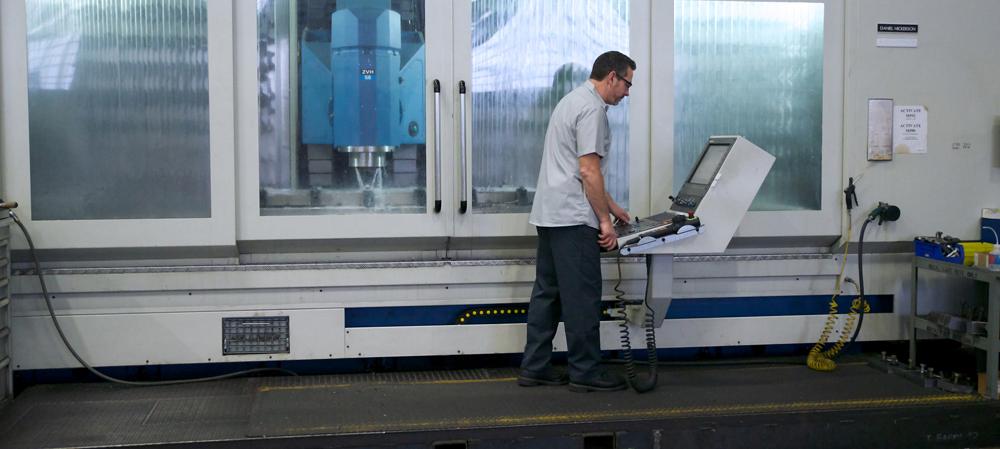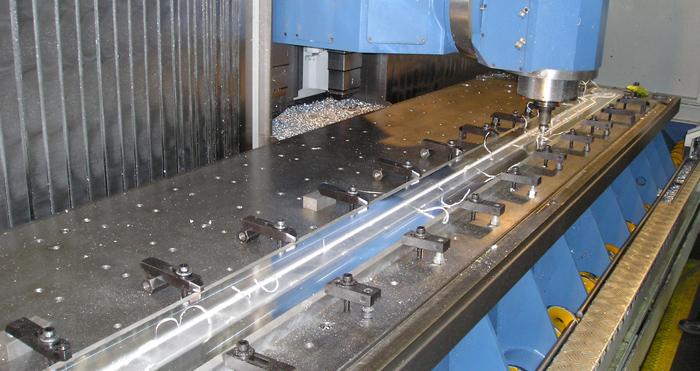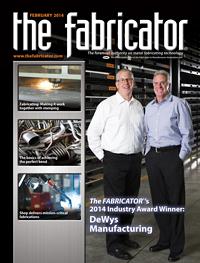Senior Editor
- FMA
- The Fabricator
- FABTECH
- Canadian Metalworking
Categories
- Additive Manufacturing
- Aluminum Welding
- Arc Welding
- Assembly and Joining
- Automation and Robotics
- Bending and Forming
- Consumables
- Cutting and Weld Prep
- Electric Vehicles
- En Español
- Finishing
- Hydroforming
- Laser Cutting
- Laser Welding
- Machining
- Manufacturing Software
- Materials Handling
- Metals/Materials
- Oxyfuel Cutting
- Plasma Cutting
- Power Tools
- Punching and Other Holemaking
- Roll Forming
- Safety
- Sawing
- Shearing
- Shop Management
- Testing and Measuring
- Tube and Pipe Fabrication
- Tube and Pipe Production
- Waterjet Cutting
Industry Directory
Webcasts
Podcasts
FAB 40
Advertise
Subscribe
Account Login
Search
Mission-critical metal fabrication
Contract manfufacturer carves a high-end niche
- By Tim Heston
- February 17, 2014
- Article
- Shop Management
In October 2000 the crew aboard the USS Cole endured a terrorist attack off the Yemen coast, and Greg Kramer, manufacturing technology manager at General Tool Co. (GTC), remembers it well. Suicide bombers blew out one of the ship’s compartments directly adjacent to one of the shipboard generators. Despite the blast, the generator, along with several others that powered the onboard systems, continued functioning. Those generators happened to be fabricated and assembled at GTC, and customers passed along their thanks, recognizing the Cincinnati contract metal manufacturer for a job well done.
Now a third-generation family business, GTC has evolved to become a diversified contract manufacturer with extensive machining and fabrication capability. It has an impressive equipment list: CNC lathes and machining centers, including the horizontal, boring, vertical, and 5-axis varieties, many with large work envelopes; a robot welding cell (see Figure 1); and nondestructive examination capabilities, including magnetic particle, X-ray, and die penetrant, with several on-staff Level III certified welding inspectors (CWIs). The shop recently installed a new Faro laser tracker and a Flow 5-axis waterjet system.
All impressive, but as experience has shown, and as customer praise after the attack on the USS Cole proved, equipment lists count for only so much in the scheme of things. No matter how eye-popping the technology, the means of getting a job done is secondary; the result is primary.
Shop Class
GTC’s story began in shop class. Greg Kramer’s grandfather was a vocational instructor for the machining trades. “He thought that if students were going to make the parts and machine things, they should be doing something productive,” Greg said.
“So he would seek out meaningful work for them to do as they learned. That was the genesis. And they were so productive, he decided to turn the operation into a real business, rather than just a sideline of his teaching. So in 1947 he launched a company.”
GTC began life in a 30- by 70-square-foot building that’s still on-site, across the parking lot from the company’s current lobby, which is now in the center of a complex that includes more than 300,000 sq. ft. of manufacturing and office space.
“You can gain a history of this place by looking at the roofline,” Kramer said, pointing to subtle but noticeable lines in the ceiling that show where additions were made, usually when a new customer or project came online that required GTC to expand its equipment arsenal. The company expanded the building 20 times over the decades, bit by bit, and purchased property across the street. That building now houses the fabrication department, which includes a new three-station robot welding cell.
Adjacent to this is a room with some large 5-axis machining centers as well as a machine that looks to be another large CNC mill—and it is, but along with milling and drilling, it is also fitted with a pin that, from a metal cutting perspective, doesn’t look very useful. That’s because it doesn’t cut; it joins via an advanced process that’s still somewhat rare in contract manufacturing. It’s a friction stir welding head (see Figure 2).
Friction Stirred, Not Melted
GTC adopted the technology to satisfy a unique project proposal sent its way in the late 1990s. Lawrence Livermore National Laboratory was starting to build the National Ignition Facility (NIF), a project of science-fiction proportions.
Housed in a 10-story building the size of three football fields, NIF has 192 lasers that, according to the government, work together to deliver at least 60 times more energy than any previous laser system. More than 1 million joules of ultraviolet energy focus on a tiny target, simulating the conditions seen only in the core of stars. One of NIF’s major, rather grand goals is to develop a way to sustainably produce nuclear fusion on this planet.

Figure 2
This large machine tool mills, drills, taps—and performs friction stir welding. The company integrated a shoulder-and-pin
tool into the machine to perform the specialized welding process for specific applications
Being the world’s largest laser facility, it needed some lenses. The plan was to house them in phone booth-sized aluminum enclosures. Engineers first constructed them from cast aluminum, but in early tests conducted on a smaller scale, they uncovered problems with outgassing and contamination. The initial proposal sent to GTC called for wrought aluminum—massive, extraordinarily expensive solid panels—precision-machined and -assembled to hold the lenses.
“It was just hard for our engineers to swallow,” Greg said. “So they did some research and Googled this friction stir welding process.”
To learn more, GTC engineers contacted The Welding Institute (TWI), where the process was invented in the early 1990s. Friction stir welding (FSW) is a solid-state joining process; the metal isn’t melted but instead stirred by a rapidly rotating shouldered pin fed at a constant rate. The frictional heat causes the two base materials to soften and mix together without melting.
Looking at the technology, GTC engineers thought they had found the answer. The process could produce welds without melting the base material, which was critical for overcoming some of the purity and contamination problems NIF encountered previously.
GTC purchased a license for FSW—one of the few North American organizations to do so at the time—and went about looking for a builder to put together a machine. Builders responded with million-dollar prices and 12- to 14-month lead-times.
“And we had to deliver our first components within four months,” Greg said. “So in typical General Tool fashion we said, ‘Well, I don’t see what’s so hard about this process and building a machine.’ So we undertook the challenge and successfully built our first friction stir welder, literally out of scrap in our yard.”
The machine was small and not pretty to look at, but it did the job. Admittedly, the FSW application was straightforward, with short, straight welds. The greatest challenge at the time, in fact, was standardizing drawings, symbology, and process procedures. By the late 1990s FSW was out of the lab, but it wasn’t well-documented. The American Welding Society hadn’t yet published a standard, and most welding engineers were unfamiliar with the process.
All the same, building a machine at a fraction of the going rates got TWI’s attention. The institute wanted to sell more FSW licenses, and when companies asked it where to find a cost-effective builder, it recommended GTC. In the ensuing years the contract fabricator doubled as a machine tool builder, exhibiting at FABTECH® and putting together various machines and sending them to customers’ plants.
The largest two GTC built for a large aerospace contractor that used it to join the aluminum lithium tanks of a space shuttle. The systems were decked out with seam tracking, vision systems, and temperature compensation devices that controlled the weld path to account for the pin’s thermal growth, which was significant because the seams were so long.
“Those [FSW] systems were everything that the simple first machine we built was not,” Greg said.

Figure 3
A rapidly rotating friction stir welding pin, integrated within a large machine tool at GTC,
performs a weld. The frictional heat causes the two base materials to soften and mix together
without melting.
The company hasn’t built FSW machines recently. In fact, Greg said he wonders how the market will change, now that certain process patents are set to expire. But he did point to a friction stir weld on a workpiece in the shop. It was curved—not a typical FSW joint geometry, but there it was. It also had some drilled and tapped holes, as well as milled pockets. Turns out, GTC performed all of these operations in one machine tool.
Greg then showed off that machine tool, a CNC vertical machining center with a large work envelope and a custom-designed head for holding an FSW shoulder-and-pin assembly (see Figure 3 and Figure 4). The machine doesn’t have the clamping or force capabilities for extreme applications, but it works well for the right order. The machine currently works on several jobs, the details of which are under wraps because of nondisclosure agreements.
Standardizing Information Flow
Greg’s father and company chairman William Kramer handed the day-to-day management duties to the next generation several years ago. Greg’s brother Bill Kramer is president, and his brother-in-law Brad Brezinski is vice president and CFO (see Figure 5).
“For my father, it was always about flexibility and availability,” Greg said, explaining that machines had to be available for production and be changed over quickly between orders. That’s a foundational philosophy for many job shops.
Recent changes have related to both company organization and technology. As chief technologist, Greg led the effort to standardize CNCs on the shop floor. Over the decades the company invested in machines to meet specific customer demands. Managers weren’t beholden to one machine toolmaker. Instead, they bought the best machine to meet a customer’s application requirements. This served GTC well over the years, but it had an unintended consequence: The machines had different brands of CNCs, each with its own control interface. By 1990 or so, the shop had 16 different types of CNCs running in the machine shop.
“We had equipment from all over the world, because we always wanted to buy the most flexible and ideal solution to the problem at hand,” Greg said. “But I came through the drafting and NC side, and I saw the havoc it created.”
Operators who weren’t familiar with a particular control couldn’t operate the machine effectively. So people couldn’t move from machine to machine as needed. Different controls also added complexity to program postprocessing and CNC maintenance. So in recent years the company standardized and retrofitted its machinery to use just a few common types, from Fanuc and others.
The company also has a homegrown software system that acts as a searchable database of job parameters. It’s essentially a record of every machining job performed at GTC over the past decade. What cutting tool worked well for this material and part geometry? Using various search filters, engineers query the job database to find out. The system also houses a similar, albeit less extensive, database on weld process parameters. It ties directly into a quoting and scheduling system, also homegrown and tailored for GTC’s project mix.
Managers are careful not to say “part mix.” Making parts isn’t the contract manufacturer’s forte. It focuses instead on large assemblies and complicated, high-end projects. In the 1990s, though, the company still was structured as if it were in the piece-part business, especially in the front office, where departments were centered around job descriptions, be it estimating, purchasing, engineering, or anything else.
Those in manufacturing have always complained about the inefficiencies of “throwing the project over the wall,” from sales and estimating to design to manufacturing engineering to procurement, to programming and scheduling, to (at long last) the shop floor. GTC’s wide range of projects only made the problem worse.
The amount of information conveyed among departments was truly staggering. The more information there was, the easier it was for miscommunications to occur. Moreover, the nature of each project was different. Some lasted only weeks or months, others lasted years. Some entailed thousands of parts, others just a few. That’s why GTC moved toward what it calls its “team of experts” approach.
Rajan Suri, author of It’s About Time and developer of quick response manufacturing (QRM), an improvement methodology, describes a front-office cell dedicated to a market segment or customer group. This cross-functional team of engineers, estimators, and purchasers work together to shepherd a job through the front office to the shop floor.
GTC’s concept is similar, but it’s set up to handle large or complex projects. In the late 1990s the company reorganized personnel into teams dedicated to specific market segments, but this since has evolved. The project mix is just too big, and it varies over time, so dedicating teams to certain markets proved problematic. Besides, two jobs in different markets—say, one in aerospace, another in telecommunications—may present similar engineering challenges.
Ultimately, the company took a hybrid approach. One team of experts still includes everyone needed to shepherd a project through manufacturing, from sales and estimating to design and engineering. That team may be dedicated to one long-standing customer. One, for instance, has been dedicated to fabricating the ship generators—the ones used on the USS Cole—for years on end. But for the most part, employees serve on several teams serving various customers.
The teams are formed based on what projects GTC has. Much of the time project leaders become familiar with certain industry segments, but because of the contract manufacturer’s high variety of projects, they aren’t limited to those industry segments either. At the same time, these teams draw expertise from certain shared resources, including CNC programming and engineering.
The arrangement helps build customer relationships and streamlines communication. As Greg explained, “Even though we’re an organization of 250 people, customers deal with a focused group of a half dozen individuals or fewer. So they really get to know the team, and they always have the project manager as the single point of contact.”
Sharing Knowledge
GTC also opened a formal project management office. The office forms teams around new jobs and closes a project out upon completion. “There’s also a ‘lessons learned’ that’s published at the completion of big projects,” Greg explained. “It can be technical in nature, or it can be project management-oriented.” This ensures that knowledge gained doesn’t stay tribal and undocumented, but instead spreads throughout the company. Ultimately, it’s that shared knowledge that makes the company better, Greg said.
After the attack on the USS Cole, GTC’s customers didn’t thank the company because of its precision machining or perfect welding. They thanked the company because—by fabricating reliable and robust generators—the company helped save the onboard crew. You can’t get more mission-critical than that.
About the Author

Tim Heston
2135 Point Blvd
Elgin, IL 60123
815-381-1314
Tim Heston, The Fabricator's senior editor, has covered the metal fabrication industry since 1998, starting his career at the American Welding Society's Welding Journal. Since then he has covered the full range of metal fabrication processes, from stamping, bending, and cutting to grinding and polishing. He joined The Fabricator's staff in October 2007.
subscribe now

The Fabricator is North America's leading magazine for the metal forming and fabricating industry. The magazine delivers the news, technical articles, and case histories that enable fabricators to do their jobs more efficiently. The Fabricator has served the industry since 1970.
start your free subscription- Stay connected from anywhere

Easily access valuable industry resources now with full access to the digital edition of The Fabricator.

Easily access valuable industry resources now with full access to the digital edition of The Welder.

Easily access valuable industry resources now with full access to the digital edition of The Tube and Pipe Journal.
- Podcasting
- Podcast:
- The Fabricator Podcast
- Published:
- 04/16/2024
- Running Time:
- 63:29
In this episode of The Fabricator Podcast, Caleb Chamberlain, co-founder and CEO of OSH Cut, discusses his company’s...
- Industry Events
16th Annual Safety Conference
- April 30 - May 1, 2024
- Elgin,
Pipe and Tube Conference
- May 21 - 22, 2024
- Omaha, NE
World-Class Roll Forming Workshop
- June 5 - 6, 2024
- Louisville, KY
Advanced Laser Application Workshop
- June 25 - 27, 2024
- Novi, MI


































